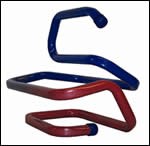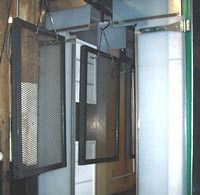Total Automation Finds a Total Solution
When Jim Galvin, owner of Total Automation, Inc., decided to reinvest in his shop's cleaning and pretreatment process, he turned to an "all-in-one" cleaning and pretreatment process…
Jim Galvin is the owner of Total Automation, Inc., a job shop located in Columbia Station, OH, a suburb of Cleveland. He started Total Automation in 1990 and expanded the company's capabilities two years ago by purchasing a company that had been in business under other names since the 1970s. Most recently, it had been called Columbia Industries and had specialized in material handling equipment and basic manufacturing. Today, Total Automation is a full-service job and fabrication shop.
Before Jim's arrival, Columbia Industries had cleaned and phosphated parts in a conventional washer prior to applying wet topcoats. The shop transitioned to powder coating shortly before it was sold to Galvin.
After purchasing Columbia Industries, Galvin noticed that the parts washer had deteriorated to the point that it needed to be replaced. He decided to use the opportunity to add capacity to the system and began designing a several-stage washer.
Midway through his washer design and purchase program, Galvin received information that led him to do some more research online about systems. He stumbled across a technical article describing a process called Plaforization™, which was being used by Johnston Metalworks, Inc. of Cheboygan, MI. After reading the article, he talked to Jay Johnston, the company's owner, and decided to explore the process further.
About the Process
Plaforization is a single-stage, rinse-free pretreatment process. The installation can be anything from a small manual dip tank to an in-line or indexed conveyorized dip or very low-pressure spray system. Rather than requiring skimming and dumping of process oils, it uses them in the pretreatment itself, taking them into solution rather than floating them. The fluid also contains the phosphating materials and a polymeric resin. In the bath, the fluids clean the oils and fines off the part, and the phosphoric acid etches the metal surface and then works with the substrate metal to create and deposit an inorganic phosphate of that metal (iron phosphate on steel, zinc phosphate on galvanized steel, for example).
When the part is removed from the treatment solution, it carries with it a small amount of the solution with a polymer resin in it, and the dragout includes the dissolved process oils (the result is that the bath does not become saturated with oil or require that the oil be skimmed and dumped). During drying, the resin cures and polymerizes, encapsulating the process oils inside the resin polymer and uses them as a plasticizer to lend flexibility and impact resistance to the surface sealant.
The part is phosphated and sealed in one step, and the one-micron polymer acts to give the part excellent resistance against flash rusting—for weeks or months in normal storage conditions.
According to Galvin, the solution never needs to be changed because the polymer absorbs the oil, and the continuous filtration system removes the dirt. All that is necessary is to top off the liquid.
Since no water is used, there is no wastewater disposal or treatment. The process also creates no sludge, so there are also no solid-waste disposal considerations. The solution does not contain any CFCs, HAPs, chrome or ozone-depleting substances.
Environmental Advantages
For both Galvin and the former owner of the business (who still owned the land and was concerned about environmental issues), pollution control was a big issue.
Galvin talked with his local EPA air pollution environmental specialist about the new process. Because of very low vapor pressure and volatility and low ability to photochemically react in the atmosphere, the chemistry is virtually VOC-free (between zero and less than five grams per liter VOC) under the federal standard. Also, according to Galvin, it contains no halogenated compounds, ozone-depleting compounds, carcinogens, mutagens or hazardous air pollutants. After review of the Material Safety Data Sheet and revised calculations, the EPA specialist concluded that the addition of Plaforization would not trigger a need for a permit modification for the plant.
Because Total Automation is not on a city sewer and dumping contaminated water into the aquifer that would be feeding the surrounding fields was not an option, Galvin's waste disposal choices were limited. Because Plaforization uses no water and is not rinsed, there would be no impact on his area's water at all. An added benefit would be the fact that the process does not create sludge and oil is not dumped either, so nothing goes to the landfill except the bags used to filter out the fines that come in on the parts.
Because Plaforization is a room-temperature process, Galvin has been able to save on the energy costs that would have been involved in heating a conventional water-based system. Natural gas prices have doubled in the last three years and show no signs of abating, so this was an extremely important issue to the shop, now and for the future.
Finally, Galvin says that maintenance has become much simpler. The one-step system requires no daily bath checks, only bi-monthly analyses conducted by the supplier. It has a single bath, no rinses and the bath is not dumped, just topped off as needed. And equipment is simpler and easier because pressures are lower, exhaust is minimal, and therefore pumps and motors are fewer and smaller.
Other Benefits
Before committing to the Plaforization process, Galvin says he ran salt spray, adhesion and impact tests on a variety of parts. Many of Total Automation's customers do not have salt spray requirements, but Galvin wanted to be able to offer corrosion resistance as a value-added benefit. Tests run by Galvin and his customers turned out very well.
Satisfied with the technology's environmental and qualitative merits, Galvin began designing his new system, with assistance from the supplier's representative and others. Several months later, the shop had a flowcoat (very low-pressure spray) installation in place, and it started operations in June 2004. He has made a few modifications since then and is using that system exclusively for his pretreatment.
Total Automation treats only steel at the present time, although the company may move to treating some other metals including aluminum when the opportunity arises. Parts vary quite a bit in size and shape, and Galvin designed the tunnel to be able to accommodate this variation, so that he can meet the needs of his customers and not have to turn away business.
Total Automation is now able to provide its customers with high-quality, full-service pretreatment and powder coating, all while also being environmentally friendly and saving money by not paying to heat his tank of pretreatment materials. "We have seen a great reduction in our labor cost, downtime and maintenance, as well as the part rejections we used to get due to adhesion problems," he says.
Galvin has increased his capacity so much that he says he can take on significant additional work without strain on his existing production. As a result, he can do both additional custom work and also the high-volume jobs some of his customers require.
Related Content
Products Finishing Reveals 2024 Qualifying Top Shops
PF reveals the qualifying shops in its annual Top Shops Benchmarking Survey — a program designed to offer shops insights into their overall performance in the industry.
Read More12 Ways to Improve Your Powder Coating Quality
Often overlooked powder coating procedures that can help you elevate your quality, streamline your operations and improve your profitability.
Read MoreSelecting the Right Outdoor-Durable Powder Coating
The powder coating industry offers an array of chemistries to provide an excellent match to the manufacturer’s expectations for outdoor durability.
Read MoreProducts Finishing Reveals 2023 Qualifying Top Shops
Each year PF conducts its Top Shops Benchmarking Survey, offering shops a tool to better understand their overall performance in the industry. The program also recognizes shops that meet a set of criteria to qualify as Top Shops.
Read MoreRead Next
Episode 45: An Interview with Chandler Mancuso, MacDermid Envio Solutions
Chandler Mancuso, technical director with MacDermid Envio discusses updating your wastewater treatment system and implementing materials recycling solutions to increase efficiencies, control costs and reduce environmental impact.
Read MoreEducation Bringing Cleaning to Machining
Debuting new speakers and cleaning technology content during this half-day workshop co-located with IMTS 2024.
Read MoreA ‘Clean’ Agenda Offers Unique Presentations in Chicago
The 2024 Parts Cleaning Conference, co-located with the International Manufacturing Technology Show, includes presentations by several speakers who are new to the conference and topics that have not been covered in past editions of this event.
Read More
















.jpg;maxWidth=300;quality=90)







